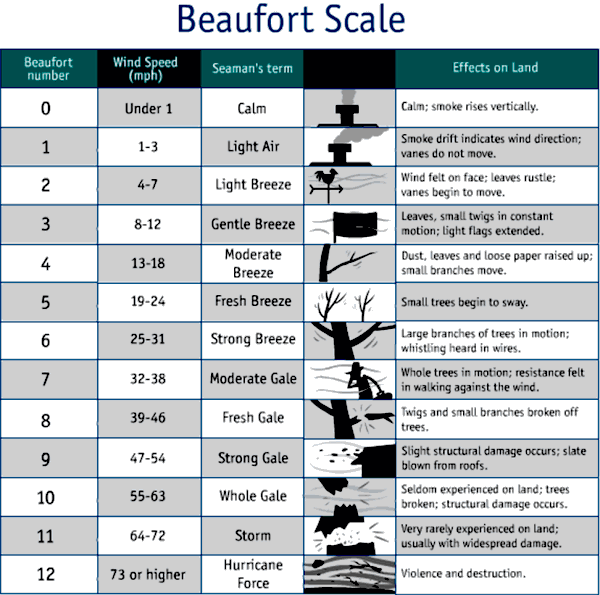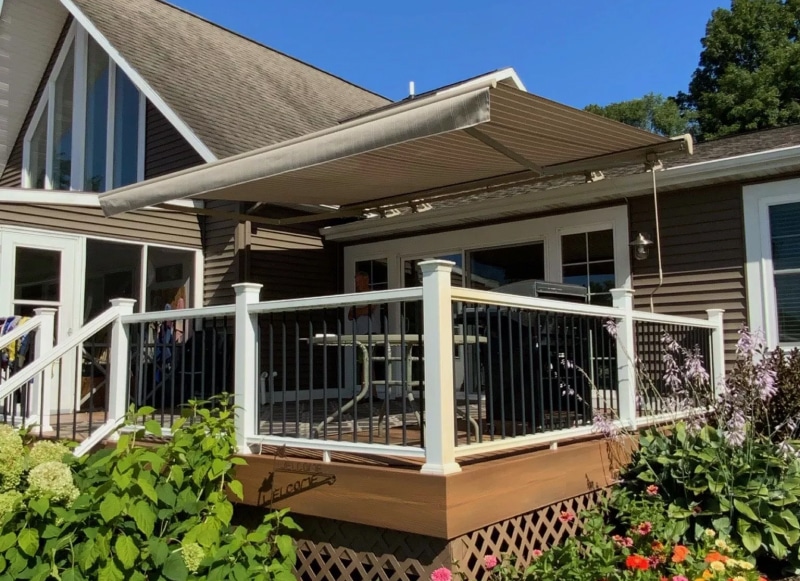Creating a comfortable and inviting space outside during the hot summer months is easy with a retractable awning, but can retractable awnings withstand wind?
Understanding the wind load capacity on the retractable awning can help you determine how you can make the most of your investment and keep your outdoor living area ready for family and friends to enjoy any time. Unlike other types of awnings, retractable awnings come with some safeguards in place that provide protection from high winds versus traditional options.
Awnings and Wind Ratings
A wind rating is just a measure of how much force from wind speeds something can handle. These ratings are usually developed in a wind tunnel, which is a controlled setting.
The Beaufort Scale is a wind speed rating system developed and used by the National Weather Service to measure wind speeds. It goes from 0-12, with zero being so still that water is flat and shiny, like a mirror, to 12, which is a violent hurricane.
Most retractable awnings can withstand wind speeds of up to 20-25 mph, which translates to a level 5 on the Beaufort Scale, or 17-21 knots. To give you an idea of what this looks like, think of small trees with leaves on them swaying in the breeze.
It’s worth noting that the wind rating on the Beaufort Scale just before this one – level 4 – occurs when small pieces of paper and dust are lifted into the air. If you see bits of things flying through the air in the breeze, that much wind is when you should bring your retractable awnings in. See below for a handy chart outlining each level on the Beaufort scale.

What Happens If My Awning Gets Hit With High Winds?
There are few things that can happen if your awning is caught in high wind gusts.
The first thing is that the weather could force the retractable awning to collapse and hit the structure behind it. The speed that this happens at will vary with different wind speeds, but the point is that too much wind will cause the retractable awnings to bash into the home or into other things in the area if they come detached from the home.
Homeowners will also want to know that the fabric canopy could potentially become damaged if it’s left in an outdoor setting in windy conditions. Wind damage can look like rips in the fabric canopy or damage to the frame of a retractable awning.
How Can I Protect My Awning Against Wind?
One of the best solutions for people who live in an area that’s windy is to install a wind sensor on their retractable awning.
This simple device, which is fixed to the outer edge of the fabric awning, checks every few minutes to see how much the awning is swaying in the breeze. It can be set to retract the awning at a safe wind speed that you can preset based on the wind rating.
For example, you could set your awning to retract automatically at a level 4 on the Beaufort Scale just to be sure that it’s safely in before a strong gust pulls it too hard. Sensors are a smart investment for homeowners in areas that are prone to seasonal winds, strong storms, hurricanes, and even powerful winter storms.
More than anything, wind sensors give you peace of mind because they’ll automatically take care of the extended awning over your patio or deck. There’s no need to rush home and check on it when weather elements start to increase.


Using a Wind Pole Attachment
One other note – if you live in an area that is prone to stronger winds, consider getting wind pole attachment added to your quality retractable awnings. This will give your awning some added ability to withstand wind speed.
When to Retract Your Awning Due To Wind
The best advice is to retract your awning on any day that is forecast to have high winds.
That sounds simple enough, but of course, high winds can easily sneak up on us. If you notice that the leaves in the trees are swaying more than usual, or if you see the flags flying a little rough in the breeze, it’s a good idea to go ahead and retract your awning.
This is especially true if you know that you’re going to leave your property and won’t be able to bring retractable awnings in while you’re out. This way, if you’re away from your home and wind speeds increase, then you won’t be worried about what your retractable awning is doing at home.
Does Pitch Affect Wind Resistance?
A retractable awning’s ability to withstand wind is affected by the pitch of the awning.
During high winds, the force pushes objects up towards the sky, not down towards the ground. When an awning has a flatter pitch, meaning it’s closer to being parallel with the ground, then the wind has an easier time of pushing up on the awning and causing wind damage.
- steep awning pitch
- flat awning pitch
If a retractable awning has a steeper pitch, meaning the outside edge is closer to the house and the angle is smaller, then the wind can’t get under it quite so easily.
For those who live in areas with higher wind conditions, it’s a good rule of thumb to ask your installer to install your awning with a steeper pitch during installation. This will let less wind under it, making it less dangerous during high wind speeds. Luckily, Marygrove Awnings feature an adjustable pitch feature that allows you to easily adjust the pitch of your awning at any time.
The Best Way To Protect Your Retractable Awning From Wind
The best way to protect your retractable awning from high winds is to make sure that you bring it in when wind speed is going to be high.
The great news is that you can rely on wind sensors to make this process easy for you. A wind sensor or motion sensor as they’re sometimes called will take some of the pressure off of you. There’s no reason to worry about your retractable awning getting damaged by high winds.
The more you protect your retractable awning from wind damage, the longer it will last, and the more you can enjoy it with your family and friends. Marygrove retractable awnings are perfect for homeowners who want a great shade solution for their outdoor space that will also automatically retract during times of high wind.

David Tavidian
David Tavidian is the Vice President of Sales at Marygrove Awnings, leading a team of over 50 sales professionals across 22 states. His expertise in retractable awnings and shading solutions ensures homeowners and businesses receive high-quality, durable products tailored to their needs. When not helping customers find the perfect awning for their backyard application David enjoys spending time with his family, debating the finer aspects of life, creating art, and relaxing under a Marygrove awning during a light rain.
Favorite Marygrove Awning - Cafe Black with Bronze Frame.


